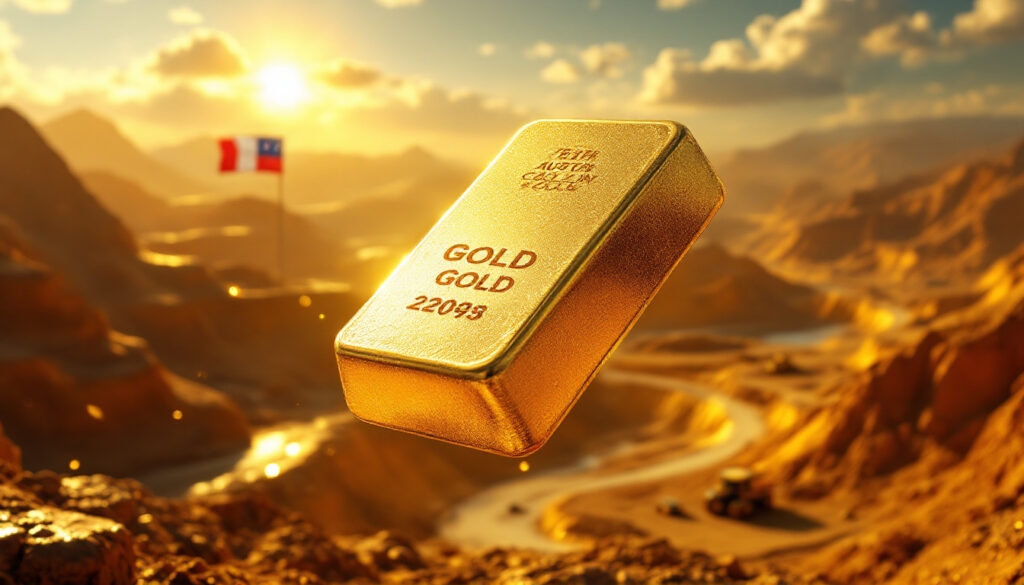Why Are Gold Prices Jumping in 2025?
The precious metals market has witnessed a remarkable surge in recent weeks, with gold prices jumping significantly amidst a backdrop of economic uncertainty and geopolitical tensions. Gold has reinforced its reputation as the premier safe-haven asset, with prices soaring over 2% on Monday to reach $3,316 per ounce for spot gold, while US gold futures climbed even higher to $3,328 per ounce.
This impressive rally has effectively reversed the first back-to-back weekly losses observed in 2025, signaling strong investor confidence in gold's enduring value despite short-term fluctuations. Market analysts point to gold's position as one of the top-performing assets of 2025, with its trajectory closely tied to broader economic indicators and global trade relations.
"Gold continues to demonstrate its resilience as a store of value during periods of market uncertainty. The recent price surge confirms investors' flight to safety amid growing economic concerns." – World Gold Council
Economic Uncertainty Driving Gold's Rally
The persistent economic uncertainty plaguing global markets has become a primary catalyst for gold's strong performance in 2025. Investors increasingly view gold's role as a hedge against potential market downturns, currency devaluation, and inflation risks that continue to threaten portfolio stability.
Recent economic data showing slowing manufacturing activity and labor market cooling in major economies has intensified concerns about potential recession risks. Gold's negative correlation with economic optimism has worked in its favor, as institutional investors reallocate portions of their portfolios toward protective assets.
The metal's limited supply characteristics and historical performance during economic downturns continue to attract investment capital, with physical gold ETFs reporting significant inflows throughout the first half of 2025.
Trade Tensions and Political Factors
Escalating trade tensions have emerged as a significant driver behind gold's recent price jump. New tariffs announced by President Trump, particularly the headline-grabbing 100% levy on foreign movies, have heightened market nervousness and trade uncertainty.
These protectionist measures have sparked concerns about retaliatory actions from major trading partners, potentially disrupting global supply chains and economic growth forecasts. The resulting market volatility has predictably benefited gold prices, as investors seek shelter from unpredictable trade developments.
Additionally, the weakening US dollar—which typically moves inversely to gold prices—has provided further support for the yellow metal. As the dollar's purchasing power diminishes against other major currencies, gold becomes more attractive to international investors seeking to preserve wealth.
Political developments across several regions have introduced additional uncertainty into global markets:
- Upcoming elections in three G7 economies
- Territorial disputes in the South China Sea intensifying
- Middle East tensions affecting energy markets
- European political fragmentation challenging economic unity
Each of these factors has contributed to an environment where gold's traditional role as a political risk hedge has gained renewed prominence.
How Does the Federal Reserve Impact Gold Prices?
The relationship between Federal Reserve policy and gold prices represents one of the most closely watched dynamics in the precious metals market. This connection has become particularly significant in 2025 as investors anxiously await clarity on the central bank's monetary policy trajectory.
Current Fed Meeting Expectations
Investors rushed to gold positions ahead of a key Federal Reserve meeting scheduled for this week, demonstrating the metal's sensitivity to anticipated central bank decisions. Market analysts widely anticipate the Fed will maintain current interest rates at this meeting, though the accompanying commentary may prove more consequential than the rate decision itself.
Financial markets are closely monitoring signals from Chair Powell regarding:
- The pace and timing of potential future rate adjustments
- Updated inflation projections through 2026
- Economic growth forecasts amid conflicting data
- Balance sheet reduction strategies
The Fed's commentary on inflation outlook could trigger further price movements in gold, as the metal typically performs better when real interest rates (nominal rates minus inflation) remain low or negative.
Relationship Between Interest Rates and Gold
Gold's performance demonstrates a well-established inverse relationship with interest rates, particularly real interest rates. This connection explains why the metal typically thrives in low interest rate environments and why rate cut expectations can drive speculative buying in gold markets.
When interest rates fall, the opportunity cost of holding non-yielding assets like gold decreases. Conversely, in high-rate environments, interest-bearing investments become relatively more attractive than gold, which generates no income stream.
The following factors illustrate this relationship in the current market context:
- Opportunity cost dynamics – Lower rates reduce the appeal of interest-bearing alternatives
- Currency effects – Rate cuts often weaken the dollar, boosting gold prices
- Inflation expectations – Lower rates may signal concerns about economic growth
- Institutional positioning – Fund managers adjust gold allocations based on rate expectations
Historical data confirms that gold has delivered its strongest performance during periods when the Federal Reserve embarks on sustained easing cycles, particularly when such cycles coincide with economic uncertainty.
What Major Gold Industry Acquisitions Are Happening in 2025?
Industry consolidation has accelerated in 2025 as mining companies pursue strategic advantages during a period of strong gold prices. These acquisition activities highlight shifting dynamics in global gold production and corporate strategy.
Gold Fields' Strategic Australian Takeover
In a significant industry development, Gold Fields has struck a AU$3.7 billion (US$2.4 billion) deal to acquire Gold Road Resources, securing full control of the productive Gruyere gold mine in Western Australia. This strategic acquisition represents a major expansion of Gold Fields' Australian operations and production capacity.
The deal's structure includes a cash offer plus additional value linked to Gold Road's stake in Northern Star Resources, providing shareholders with exposure to further upside potential. Gold Road's board has enthusiastically supported the offer, describing it as a premium deal that delivers substantial value to shareholders.
Full ownership of Gruyere is expected to enhance Gold Fields' cash flow and operational flexibility in several ways:
- Streamlining mine management decisions
- Eliminating partnership constraints on expansion planning
- Optimizing production scheduling based on market conditions
- Implementing technological improvements without partner approval
- Centralizing procurement to achieve economies of scale
The acquisition continues Gold Fields' strategy of building a global portfolio of long-life, low-cost gold operations with significant production potential.
Industry Consolidation Trends
This transaction marks the third major gold acquisition in Australia this year, underscoring the industry's accelerating consolidation trend. Mining companies are strategically consolidating assets during volatile gold market conditions to strengthen their competitive positions and capitalize on operational synergies.
Strategic acquisitions aim to secure production capacity during favorable price environments, allowing companies to maximize returns while gold trades near historical highs. Australian gold assets remain particularly attractive targets for international mining companies due to their:
- Stable regulatory environment
- Established infrastructure
- Skilled mining workforce
- Exploration potential
- Favorable taxation regime
Industry analysts project that consolidation may continue as companies seek to strengthen their portfolios and achieve production scale necessary to attract institutional investment. The trend reflects growing recognition that larger, more diversified operations can better weather gold price volatility while maintaining consistent returns to shareholders.
"The wave of consolidation we're witnessing in the gold sector is a natural response to record prices and the need for scale in a capital-intensive industry. Companies that can successfully integrate acquisitions while maintaining operational discipline will emerge as industry leaders." – Mining Industry Analyst
How Is Violence Affecting Gold Mining Operations Globally?
The gold mining industry faces escalating security challenges in several regions, with criminal violence increasingly disrupting operations and threatening both personnel and production capacity. These security concerns highlight the complex socioeconomic environments in which many gold operations exist.
Security Crisis in Peru's Mining Sector
A shocking incident in Peru's mining sector sent ripples through the industry when 13 security guards from the Poderosa gold mine were found murdered after being kidnapped and shot at close range in a remote shaft in the Amazonian Pataz province. The brutal attack underscores the extreme risks faced by security personnel in regions where illegal mining activities flourish.
Criminal groups linked to illegal mining operations appear responsible for the violence, which occurred despite ongoing state of emergency declarations in the area. Poderosa has publicly accused authorities of failing to shut down illegal mining entrances used by criminal gangs, highlighting the challenges of enforcement in remote mining regions.
The violence reflects several troubling dynamics:
- Territorial disputes between criminal organizations
- Ineffective government control in remote areas
- Competition for access to high-grade deposits
- Corruption undermining security efforts
- Limited resources for mine protection
This deadly attack represents the most severe security incident in Peru's mining sector despite government efforts to control illegal mining activities and associated violence.
Illegal Mining's Economic Impact
The economic scale of illegal gold mining has reached staggering proportions, with Peru's illegal gold production estimated at over $6 billion last year alone. This shadow economy creates powerful incentives for criminal organizations to maintain control over mining territories through violence and intimidation.
Violence in mining regions has surged as criminal groups compete for control of lucrative illegal operations, creating significant operational risks for legitimate mining companies. These security challenges increase production costs through:
- Enhanced security infrastructure requirements
- Higher insurance premiums for operations in high-risk areas
- Production disruptions during security incidents
- Difficulties recruiting skilled personnel for remote sites
- Community relations complications in affected regions
The economic incentives for illegal mining increase during periods of high gold prices, with criminal groups capitalizing on gold's value while avoiding regulatory compliance costs, taxes, and environmental responsibilities. Government response capabilities remain stretched thin across remote mining regions, where enforcement faces both geographical and resource constraints.
What Technological Innovations Are Transforming Mineral Exploration?
The mineral exploration sector is undergoing a technological revolution that promises to dramatically improve discovery rates while reducing exploration costs and environmental impacts. These innovations are reshaping how mining companies approach the challenge of replenishing reserves.
Satellite Technology in Mining Exploration
A groundbreaking partnership has emerged between Australian space tech firm Fleet Space Technologies and Saudi mining company Ma'aden, with the signing of a 4-year deal to explore over 12,000 square kilometers across the mineral-rich Arabian Shield. This collaboration represents a major expansion of Fleet Space's Middle East operations and signals growing industry acceptance of satellite-based exploration technologies.
Fleet Space's satellite-enabled Exosphere platform will deliver deep 3D subsurface imaging capabilities previously unavailable at this scale and efficiency. The technology aims to fast-track Ma'aden's mineral exploration efforts by:
- Generating comprehensive geological maps with minimal ground disturbance
- Identifying promising subsurface anomalies for targeted drilling
- Reducing exploration timelines from years to months
- Minimizing the environmental footprint of preliminary exploration
- Optimizing resource allocation to high-potential targets
This technology-driven approach exemplifies how digital innovation is transforming traditionally time-consuming and costly exploration methodologies.
Advancing Exploration Efficiency
Satellite technology significantly reduces traditional exploration timeframes through the integration of multiple remote sensing capabilities with advanced analytics. The comprehensive 3D subsurface imaging provided by these systems delivers more accurate geological data than conventional methods while requiring fewer physical samples.
Remote sensing capabilities enable exploration of difficult-to-access regions, including areas with challenging terrain, extreme climates, or security concerns. This accessibility advantage has particular relevance for untapped mineral frontiers in remote parts of Africa, Central Asia, and the Arctic.
The exploration efficiency gains come from several technological components working together:
- Satellite-based geophysical surveys – Collecting gravitational and magnetic data at scale
- Hyperspectral imaging – Identifying mineral signatures from orbit
- AI-powered analytical systems – Processing massive datasets to identify patterns
- Cloud computing integration – Enabling real-time collaboration among global teams
- Digital twin modeling – Creating detailed virtual replicas of geological formations
Strategic partnerships between tech firms and mining companies accelerate innovation adoption across the industry, suggesting that exploration techniques will continue evolving rapidly in response to the challenge of discovering increasingly elusive mineral deposits.
What Unusual Gold Discoveries Make Headlines?
While industrial mining dominates gold production, unexpected discoveries continue to capture public imagination and highlight gold's enduring cultural and historical significance. These finds often reveal fascinating chapters in human history and gold's role in it.
Historic Treasure Find in Czech Republic
A remarkable discovery unfolded when two hikers stumbled upon nearly 600 gold coins in the Krkonoše mountains of the Czech Republic. The historic treasure, which included fine jewelry tucked into a wire mesh bag and tobacco pouches, represents a significant archaeological find valued at approximately $680,000.
The century-old artifacts are now preserved at the Museum of East Bohemia, where experts are studying them to determine their precise origins and historical context. Several theories have emerged regarding who might have hidden the treasure:
- Wealthy Jewish families fleeing persecution during wartime
- Retreating soldiers concerned about looting
- Local residents hiding wealth from tax authorities
- Merchants concealing assets during economic instability
The mystery surrounding the treasure's origins adds an intriguing dimension to its historical and cultural significance, sparking public interest in the region's complex past.
The Enduring Value of Gold Through History
This remarkable discovery highlights gold's long-standing role as a store of value across centuries of human civilization. During periods of conflict or instability, people have consistently turned to gold as a portable and concealable form of wealth preservation.
The cultural significance of gold treasures in European history extends beyond their monetary value, offering insights into craftsmanship, trade networks, and social structures of past eras. Archaeological importance of undisturbed historical finds like the Czech treasure provides researchers with valuable contextual information often lost when artifacts are discovered through less controlled means.
"These discoveries remind us that gold has served as humanity's ultimate insurance policy for thousands of years. When facing uncertainty, people throughout history have consistently trusted gold to preserve their wealth." – Archaeological expert
Public fascination with treasure discoveries reinforces gold's cultural appeal in the modern era, creating a connection between contemporary investors and the historical patterns of human behavior during uncertain times.
FAQ About Gold Price Movements
What factors typically cause gold prices to jump?
Gold prices typically surge during periods of economic uncertainty, geopolitical tensions, currency devaluation, inflation concerns, and when interest rates decline. The recent 2% jump to $3,316 per ounce demonstrates how trade tensions and Federal Reserve policy expectations can trigger significant price movements. Additionally, central bank purchasing, declining mining production, and increased investment demand can create supply-demand imbalances that push prices higher.
How do central bank decisions affect gold prices?
Central bank decisions, particularly those of the Federal Reserve, directly impact gold prices by influencing interest rates and inflation expectations. When central banks maintain low interest rates or implement quantitative easing, gold often becomes more attractive as it doesn't yield interest but preserves purchasing power during currency devaluation. The anticipation of monetary policy shifts can cause significant market positioning ahead of announcements, as evidenced by recent pre-Fed meeting gold buying.
Is gold still considered a safe-haven asset in 2025?
Yes, gold continues to function as a premier safe-haven asset in 2025, as evidenced by its strong performance during periods of economic uncertainty and market volatility. Investors still turn to gold when seeking protection from inflation, currency fluctuations, and geopolitical instability. The metal's limited correlation with traditional financial assets makes it valuable for portfolio diversification, while its physical properties and universal recognition ensure its enduring appeal across different economic environments.
How is illegal mining affecting the legitimate gold industry?
Illegal mining operations, particularly in regions like Peru where violence has escalated, create significant challenges for legitimate mining companies through security threats, environmental damage, and market distortion. With illegal Peruvian gold production estimated at over $6 billion annually, these operations represent a substantial shadow industry competing with legal operations. The gold market analysis indicates social and environmental impacts of unregulated mining include mercury contamination, deforestation, and community conflicts, while the associated criminal violence increases security costs for legitimate operators.
Understanding effective Gold ETFs strategies has become increasingly important for investors looking to capitalize on gold price movements without the complexities of physical ownership. Furthermore, concerns about gold stocks performance relative to the metal itself remain a key consideration for portfolio allocation, while the gold market outlook 2025 suggests continued volatility amid evolving economic conditions.
Looking for the Next Major Mineral Discovery?
Discover significant ASX mineral discoveries as they happen with real-time alerts from Discovery Alert's proprietary Discovery IQ model, which transforms complex data into actionable investment opportunities. Visit our dedicated discoveries page to understand why major mineral discoveries can lead to substantial market returns and begin your 30-day free trial today.




